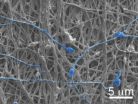(Press-News.org) New research shows first evidence of paternal voice recognition in solitary foraging species, provides insight into early primates from which humans evolved
Think of the last time you screamed. Chances are you attracted someone's attention. What about the last time someone flirted with you? You were likely more selective in your response.
New research findings from Arizona State University and the University of Veterinary Medicine Hannover in Germany demonstrate that a less social species – the grey-mouse lemur - pays attention to alarm calls regardless of whom they emanate from, but they are selective when it comes to mating calls from their fathers, paying more attention to calls from unrelated males.
Findings from the study that analyzed grey-mouse lemur calls provide the first evidence of paternal kin recognition through vocalizations in a small-brained, solitary foraging mammal, said Sharon Kessler, the principal investigator for the study and ASU School of Human Evolution and Social Change graduate student.
Grey-mouse lemurs serve as a model for the early primates from which humans evolved, she added. Early primates likely shared traits with the lemurs such as foraging in dense forests and hunting for food at night in solitude, but also engaging with each other in social groups.
"Species with less complex social systems can be models for early primates, so we can learn about our own evolution. We think that the earliest primates were very much like mouse lemurs," Kessler said. "The study allowed us to go back further in time and to take a deeper approach into time. It suggests that kin recognition through vocalizations was important for primate evolution."
The research indicates that sounds made by animals have been a vital tool to recognize kin since before complex social systems evolved in primates, "basically since the origins of primates," Kessler said.
Studying an animal that forages in solitude, and not in groups like monkeys and apes, allowed researchers to model how important kin recognition through voice would have been in a similar species from 55 to 90 million years ago. Findings will be published online Friday, Nov. 30, in BMC Ecology.
"It suggests that the paternal kin recognition can evolve without having a complex social system," Kessler said.
The research team's work began in 2008 to examine whether or not animals with smaller brains relative to body size could recognize kin through vocalizations as they forage by themselves at night. Calls were measured through frequency (how high or low the voice is) at various time points in the call, duration and intersyllable interval (how rapidly the call is repeated).
"Vocalizations are particularly important because you can communicate over a distance," Kessler said. But danger sometimes lurks in the form of predators that may hear the calls. Mouse lemurs can communicate in the high frequency and ultrasonic ranges that are too high for humans to hear. This is also too high for predators like owls to hear, meaning that that mouse lemurs can communicate without being eavesdropped by predators.
Findings of the study showed that females distinguished their fathers from unrelated males using mating calls. One explanation for being able to recognize paternal kin may be that females can use the calls to avoid mating with relatives, Kessler said.
It's compelling to consider how mouse lemurs distinguish the calls since the species is raised only by mothers, aunts and grandmothers, she added. Fathers don't help with infant care and don't share the nest with the mother and babies, so learning a father's voice while growing up doesn't seem possible.
One possibility is phenotype matching. If family members sound similar, females may compare calls of potential mates to their own calls and to the calls of their brothers (littermates) in the nest. Then if they choose mates that sound different from themselves and their brothers, they would be choosing unrelated males.
###
Authors of the article "Paternal Kin Recognition in the High Frequency / Ultrasonic Range in a Solitary Foraging Mammal," are: Kessler, ASU School of Human Evolution and Social Change and Institute of Zoology, University of Veterinary Medicine Hannover, Germany; Leanne T. Nash, ASU School of Human Evolution and Social Change; and Marina Scheumann and Elke Zimmermann, Institute of Zoology, University of Veterinary Medicine Hannover, Germany.
This research was funded by the German Research Foundation, Sigma Xi, the Arizona State University School of Human Evolution and Social Change and the ASU Graduate and Professional Student Association.
Contact:
Julie Newberg
Media Relations
Arizona State University
480) 727-3116
Julie.Newberg@asu.edu END
Grey-mouse lemurs serve as model for the early primates from which humans evolved
2012-11-30
ELSE PRESS RELEASES FROM THIS DATE:
Even brown dwarfs may grow rocky planets
2012-11-30
Rocky planets are thought to form through the random collision and sticking together of what are initially microscopic particles in the disc of material around a star. These tiny grains, known as cosmic dust, are similar to very fine soot or sand. However, in the outer regions around a brown dwarf -- a star-like object, but one too small to shine brightly like a star -- astronomers expected that grains could not grow because the discs were too sparse, and particles would be moving too fast to stick together after colliding. Also, prevailing theories say that any grains ...
Electrically spun fabric offers dual defense against pregnancy, HIV
2012-11-30
The only way to protect against HIV and unintended pregnancy today is the condom. It's an effective technology, but not appropriate or popular in all situations.
A University of Washington team has developed a versatile platform to simultaneously offer contraception and prevent HIV. Electrically spun cloth with nanometer-sized fibers can dissolve to release drugs, providing a platform for cheap, discrete and reversible protection.
The research was published this week in the Public Library of Science's open-access journal PLoS One. The Bill & Melinda Gates Foundation ...
When eating for 2 becomes a weighty issue
2012-11-30
Two-thirds of Australian mums-to-be are in the dark when it comes to how much weight they should gain during pregnancy.
Susie de Jersey from Queensland University of Technology's (QUT) Institute of Health and Biomedical Innovation (IHBI) and senior dietician at the Royal Brisbane and Women's Hospital said a third of women surveyed gained too much weight during pregnancy. Another third struggled to gain enough weight with some mothers recording a lower weight just before giving birth than they did before falling pregnant.
"The majority of the women in the study knew ...
The colour of love: Zebrafish perform colorful courtship displays
2012-11-30
Elaborate secondary sexual displays are often overlooked because many species attract mates through sensory modalities imperceptible to humans, including ultraviolet light, ultrasound, electrical signals, or pheromones. Also, sexual coloration may only be expressed briefly during courtship (ephemeral courtship dichromatisms) to avoid attracting predators. Zebrafish (Danio rerio) are a widely studied model organism, though there have been few studies on their mating behaviour. Like many schooling fish, zebrafish do not appear sexually dichromatic to humans; there are no ...
Help for European children to resist unhealthy temptations
2012-11-30
Children and young people in Europe are exposed to all kinds of fast food, crisps and fizzy drinks – so how can they learn to resist the temptation to indulge?
This is the question that the European research project TEMPEST was set up to answer. The research project involves researchers from nine European countries and one of the team members is Liliya Nureeva, a PhD student at Aarhus University.
The TEMPEST research project has prepared strategies for children to use to suppress or control their desire to scoff sweets and snacks. One of the main objectives of the ...
Clearest evidence yet of polar ice losses
2012-11-30
After two decades of satellite observations, an international team of experts brought together by ESA and NASA has produced the most accurate assessment of ice losses from Antarctica and Greenland to date. This study finds that the combined rate of ice sheet melting is increasing.
The new research shows that melting of the Antarctic and Greenland ice sheets has added 11.1 mm to global sea levels since 1992. This amounts to about 20% of all sea-level rise over the survey period.
About two thirds of the ice loss was from Greenland, and the remainder was from Antarctica. ...
New study finds what makes a good mentor and mentee
2012-11-30
TORONTO, Nov. 30, 2012—How-to books are full of advice on what makes a good mentor. But what makes a good mentee and what chemistry is needed to make the relationship work?
People being mentored should be open to feedback and be active listeners, according to a new research paper. They should also be respectful of their mentor's time, including being on time and prepared for meetings.
And it helps to follow at least some of their advice.
"Successful mentorship is vital to career success and satisfaction for both mentors and mentees," said Dr. Sharon Straus, a researcher ...
Biomarker progress offers hope for early autism spectrum disorder detection
2012-11-30
Amsterdam, NL, November 30, 2012 – Autism spectrum disorders (ASD) are neurodevelopmental disorders typically characterized by difficulties in social interactions and delayed or abnormal language development. Although ASD reportedly affects 1 in 88 people in the United States, to date there have been no distinctive biomarkers to diagnose the disease. In a special themed issue of Disease Markers, investigators report on the current understanding of ASD genetics and the possibilities of translating genetic research toward biomarker development in ASD.
"Although some individuals ...
Gulf of Mexico clean-up makes 2010 spill 52-times more toxic
2012-11-30
If the 4.9 million barrels of oil that spilled into the Gulf of Mexico during the 2010 Deep Water Horizon spill was a ecological disaster, the two million gallons of dispersant used to clean it up apparently made it even worse – 52-times more toxic. That's according to new research from the Georgia Institute of Technology and Universidad Autonoma de Aguascalientes (UAA), Mexico.
The study found that mixing the dispersant with oil increased toxicity of the mixture up to 52-fold over the oil alone. In toxicity tests in the lab, the mixture's effects increased mortality ...
How native plants and exotics coexist
2012-11-30
ROCK HILL, S.C. - When people hear about exotic plants invading a new environment, there is usually a negative connotation. They often think of plants like kudzu, Chinese privet, or Japanese honeysuckle, whose thuggish behavior can push out the native plants in their backyard or local parks.
While this worse case scenario can happen, it isn't always the case, according to ecologists at Winthrop University and Brown University in an article published in the journal Ecology Letters.
"Basically, we found that exotics plants grow more and can essentially out-compete natives, ...


